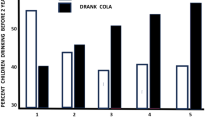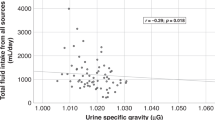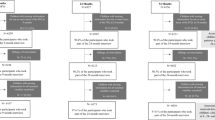Abstract
Objective: To examine the types of drinks consumed by children at 18 months of age, determine any associations with socio-demographic characteristics and investigate the use of a bottle for providing these drinks.
Design: A total of 1026 randomly chosen children from the Avon Longitudinal Study of Pregnancy and Childhood (ALSPAC) were studied.
Methods: As part of a dietary diary completed when their children were 18 months of age, mothers were asked to record all drinks consumed over a 24 h period and to report the containers used to give these drinks. Socio-demographic characteristics were obtained via self-completion questionnaire.
Results: Dietary records were available for 1026 children at 18 months. A wide variety of drinks were given at this age. In all, 64% of children had received at least one drink in a bottle and 10% solely used a bottle. Bottle users consumed a significantly greater volume of milk drinks compared to those who used a cup or other container. The types of drinks consumed and adherence to the guidelines on weaning were associated with several socio-demographic characteristics. In particular, children with mothers of lower educational level were more likely to receive fizzy drinks and low-calorie soft drinks, more likely to drink from a bottle, and less likely to drink from a cup.
Conclusion: We have shown that certain groups of mothers with 18-month-old children are not following the current guidelines on weaning. Assuming these guidelines have scientific validity, it is clear that nutritional education needs to be targeted at these mothers to help them feed their children in the optimal way, to protect from nutritional deficiencies, possible later obesity and poor dental health.
Sponsorship: University of Bristol.
This is a preview of subscription content, access via your institution
Access options
Subscribe to this journal
Receive 12 print issues and online access
$259.00 per year
only $21.58 per issue
Buy this article
- Purchase on Springer Link
- Instant access to full article PDF
Prices may be subject to local taxes which are calculated during checkout
Similar content being viewed by others

References
Cowin I, Emmett PM & the ALSPAC Study Team. 2000 Diet in a group of 18 month old children in South West England and comparisons with the results of a national survey J. Hum. Nutr. Dietet. 13: 87–100
Cowin I, Emond A, Emmett P & the ALSPAC Study Team. 2001 Association between composition of the diet and haemoglobin and ferritin levels in 18-month-old children Eur. J. Clin. Nutr. 55: 278–286
de la Hunty A, Lader D, Clarke PC . 2000 What British children are eating and drinking at age 12–18 months J. Hum. Nutr. Diet. 13: 83–86
Dennsion BA . 1996 Fruit juice consumption by infants and children. A review J. Am. Coll. Nutr. 15 Suppl 5: 4S–11S
Dennsion BA, Rockwell HL, Baker SH . 1997 Excess fruit juice consumption by pre-school aged children is associated with short stature and obesity Pediatrics 99: 15–22
Department of Health . 1991 Dietary reference values for food, energy and nutrients for the United Kingdom Report on Health and Social Subjects 41. London: HMSO
Department of Health . 1994a Weaning and the Weaning Diet. Report on Health and Social subjects No. 45. London: HMSO
Departmentof Health . 1994b Nutritional Aspects of Cardiovascular Disease Report on Health and Social Subjects 46. London: HMSO
Disler PB, Lynch SR, Charlton RW . 1975 The effect of tea on iron absorption Gut 16: 193–205
Emmett PM, North K, Noble S & the ALSPAC Study Team. 2000 Drinking habits of young infants. I. A descriptive study Pub. Health. Nutr. 3: 211–217
Foster K, Lader D, Cheesebrough S . 1997 Infant feeding 1995 London: HMSO
Frazier JP, Countie D, Elerian L . 1998 Parental barriers to weaning infants from the bottle Arch. Paediatr. Adolesc. Med. 132: 889–892
Golding J, Pembrey M, Jones R & the ALSPAC Study Team. 2001 ALSPAC–The Avon Longitudinal Study of Parents and Children. I. Study methodology Paediatr. Pernote. Epidemiol. 15: 74–87
Gregory JR, Collins DL, Davies PSW, Hughes JM, Clarke PC . 1995 National diet and nutrition survey: children aged 1½ to 4½ y. Volume I. Report of the Diet and Nutrition Survey London: HMSO
Hammer LD, Bryan S, Agras S . 1999 Development of feeding practices during the first 5 y of life Arch. Paediatr. Adolesc. Med. 153: 189–194
Hinds K, Gregory JR . 1995 National Diet and Nutrition Survey: Children Aged 1½ to 4½ Years. Volume 2: Report of the Dental Survey London: HMSO
Holt RD . 1997 Weaning and dental health Proc. Nutr. Soc. 56: 131–138
Holt RD, Moynihan PJ . 1996 The weaning diet and dental health Br. Dent. J. 181: 254–259
Hourihane JO'B, Rolles CJ . 1995 Morbidity from excessive intake of high energy fluids. The squash drinking syndrome Arch. Dis. Child. 72: 141–143
Kaste LM, Gift HC . 1995 Inappropriate infant bottle feeding Arch. Paediatr. Adolesc. Med. 149: 786–791
Merhav H, Amitai Y, Palti H, Godfrey S . 1985 Tea drinking and microcytic anemia in infants Am. J. Clin. Nutr. 41: 1210–1213
Mills A, Tyler H . 1992 Food and Nutrient Intakes of British Infants Age 6–12 Months London: HMSO
Morgan JB, Kimber AC, Redfern AM, Stordy BJ . 1995 Healthy eating for infants–mothers attitudes Acta Paediatr. Scand. 84: 512–515
North K, Emmett PM, Noble S & the ALSPAC Study Team. 2000a Types of drinks consumed by infant at 4 and 8 months of age: sociodemographic variations J. Hum. Nutr. Dietet. 13: 71–82
North K, Emmett PM & the ALSPAC Study Team. 2000b Multivariate analysis of diet among three-year old children and associations with socio-demographic characteristics Eur. J Clin. Nutr. 54: 73–80
Northstone K, Emmett P, Nethersole F & the ALSPAC Study Team. 2001 The effect of age of introduction to lumpy solids on foods eaten and reported feeding difficulties at 6 and 15 months J. Hum. Nutr. Dietet. 14: 45–54
Petter LPM, Hourihane JO'B, Rolles CS . 1995 Is water out of vogue? A survey of the drinking habits of 2 to 7 y olds Arch. Dis. Child. 72: 137–140
Price GM, Paul AA, Key FB, Harter AC, Cole TJ, Day KC, Wadsworth MEJ . 1995 Measurement of diet in a large national survey: comparison of computerised and manual coding of records in household measures J. Hum. Nutr. Dietet. 8: 417–428
Rapoport JL, Berg CJ, Ismond DR, Zahn TP, Neims A . 1984 Behavioural effects of caffeine in children: relationship between dietary choice and effects of caffeine challenge Arch. Gen. Psychiat. 41: 1073–1079
Smith MM, Lifschitz F . 1994 Excess fruit juice consumption as a contributing factor in nonorganic failure to thrive Pediatrics 93: 438–443
Watt RG, Dykes S, Sheiham A . 2000 Drink consumption in British preschool children: relation to vitamin C, iron and calcium intakes J. Hum. Nutr. Dietet. 13: 13–19
White A, Freeth S, O'Brien M . 1992 Infant Feeding 1990 London HMSO
Wune AH, Spencer AJ, Szuster FS . 1997 Infant and child feeding practices: a preliminary investigation Aust. Dent. J. 42: 54–58
Acknowledgements
We are extremely grateful to the Children in Focus parents and children who have taken part in this study, and to the midwives for their cooperation and help in recruiting the mothers during pregnancy. We would like to acknowledge the dedicated work of the ALSPAC study team; this includes interviewers, computer technicians, clerical workers, research scientists, volunteers and managers. We would particularly like to thank the staff of the Children in Focus research clinics and the students who coded the drinks data. The ALSPAC study is part of the WHO initiated European Longitudinal Study of Pregnancy and Childhood. The Children in Focus sub-study is, however, unique to ALSPAC.
Author information
Authors and Affiliations
Consortia
Corresponding author
Rights and permissions
About this article
Cite this article
Northstone, K., Rogers, I., Emmett, P. et al. Drinks consumed by 18-month-old children: are current recommendations being followed?. Eur J Clin Nutr 56, 236–244 (2002). https://doi.org/10.1038/sj.ejcn.1601313
Received:
Revised:
Accepted:
Published:
Issue Date:
DOI: https://doi.org/10.1038/sj.ejcn.1601313


